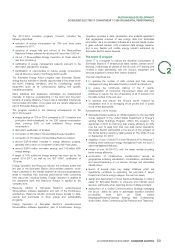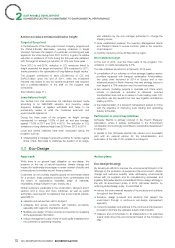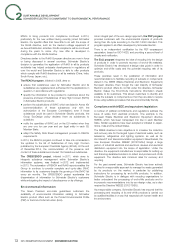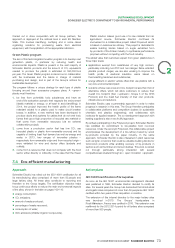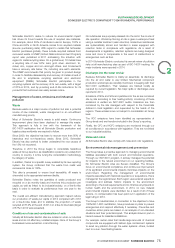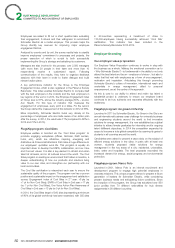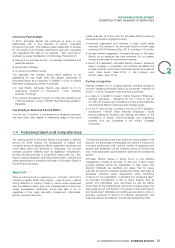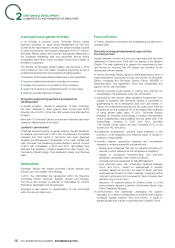APC 2014 Annual Report Download - page 80
Download and view the complete annual report
Please find page 80 of the 2014 APC annual report below. You can navigate through the pages in the report by either clicking on the pages listed below, or by using the keyword search tool below to find specific information within the annual report.
2SUSTAINABLE DEVELOPMENT
COMMITTED TO AND ON BEHALF OF EMPLOYEES
the 2nd year of the Global Safety Standardization deployment –
l
OHSAS 18001 (or equivalent) at 100percent of its manufacturing
the program to standardize safety best practices globally; in and logistics sites (sites with more than 50people and within two
2014, 7initiatives were approved for standardization; each years of creation or acquisition). The deployment of this program is
region reported quarterly updates to the global safety leader and 78percent complete at end of2014.
Global Supply Chain EVP; the objective is to have all items
Training and Communication
deployed by year end for all regions;
the 2nd year of global implementation of the Annual Safety &
l
Training and communication are key components of the
Environmental Assessments (ASEA) – an internal audit system Health&Safety program at Schneider Electric. The Group is
focused on critical safety and environmental elements that are committed to providing awareness level and task specific training
applied on a global basis to ensure conformance to for its employees and contractors to ensure a strong knowledge
standardized OHS and environmental processes, practices and base to work safely. In 2013, a new emphasis has been placed on
procedures; ensuring all employees receive a minimum of seven hours of
Schneider Production System (SPS) – to ensure continuous
l
training per year, including OHS related training. New global safety
improvement in safety and ergonomic programs, phase I of the courses continue to be added to the safety training program
SPS action plan was released in 2013; the action plan includes housed in the global training database, My Learning Link, which
a global focus on key ergonomic themes such as work tracks course requirements and course completions.
practices, training, material handling and communications; Communication is vital to an effective global OHS program and the
the first full year for the implementation of GlobES (Global
l
Group is using many communication methods to share OHS
Environment and Safety) – the new safety and environmental concerns, best practices, and successes. New communication
data management system; opportunities implemented in 2013 include a new web-based tool,
Spice, and a document sharing tool, Box. Training and
continuation of OHSAS18001 deployment.
l
communication have also been improved through the use of
Objectives
webinars covering safety related training topics, performance
reports, and action plan updates. Most of these webinars are
Schneider Electric uses three primary indicators to measure recorded for continued use as training material and are shared on
Occupational Health&Safety performance. The first of these a global basis. Regional newsletters, global performance results,
indicators is the Medical Incident Rate (MIR) which measures the Safety & Environment alerts, training material and more can be
number of medical cases permillion of hours worked. This found, strengthening the OHS ties between countries and regions.
measure allows for a deep evaluation of workplace hazards, and
Focus on stress management
the resulting corrective actions assist in the elimination of recurring
incidents and the prevention of injury. The Group has used the MIR
as a key performance indicator on a global basis since2010 with a Stress at work is managed by the Human Resources organization
target to reduce the MIR by 10% year over year. within the Group. Effective measures are in place locally to address
stress reduction in the workplace. In North America for example,
The second and third indicators are the Lost-time Incident Rate Human Resources promotes stress reduction via incentives and
(LTIR) and the Lost-time Day Rate (LTDR). The LTIR measures the communications on the healthy lifestyle program in place (exercise,
number of medical cases that incur lost-time work days permillion proper diet, smoking cessation, stress management, preventative
hours worked. These lost-time cases are indicators of a more medicine,etc.) which is encouraged both on and off the job. In
serious type of medical case. The seriousness of these cases is Asia Pacific, Human Resources promotes stress reduction via
indicated by the LTDR which measures the number of days lost health lectures, yoga class, sports club, stretching program and
due to the lost-time medical cases permillion hours worked. annual health fairs.
Schneider Electric has used the LTIR and LTDR as key
performance indicators on a global basis since2012, replacing In France, a special program has been put in place to increase
similar indicators at that time. Both indicators also have a target awareness among all actors in the Company on the prevention of
reduction of 10% year over year. psychosocial risks. Four classroom training modules for
managers/HR, OSH/health professionals, management
The 2014 results for MIR, LTIR and LTDR are as follows: committees, and health, safety and working conditions committees
MIR 2013 =2.37; MIR 2014 =1.85; reduction of 22%;
l
(CHSCT) were designed and rolled out by a network of internal HR
trainers or volunteer managers. As of the end of October2014,
LTIR 2013 =1.18; LTIR 2014 =0.93; reduction of 21%;
l
nearly 1,000 people had been trained since the launch of the
LTDR 2013 =38.67; LTDR 2014 = 29.98; reduction of 22%.
l
training courses in April2013.
Certifications
An e-learning training module, hosted by the My Learning Link
platform, was designed to raise employees’ awareness. This
In2009, Schneider Electric began the implementation of training can be triggered either by the employee or provided in
occupational health and safety management systems that meet or group training sessions and led by HR as part of the Connect
exceed the requirements of OHSAS 18001 standards. In2011, the People program.
Group revised the requirement to specifically include certification to
78 2014 REGISTRATION DOCUMENT SCHNEIDER ELECTRIC



